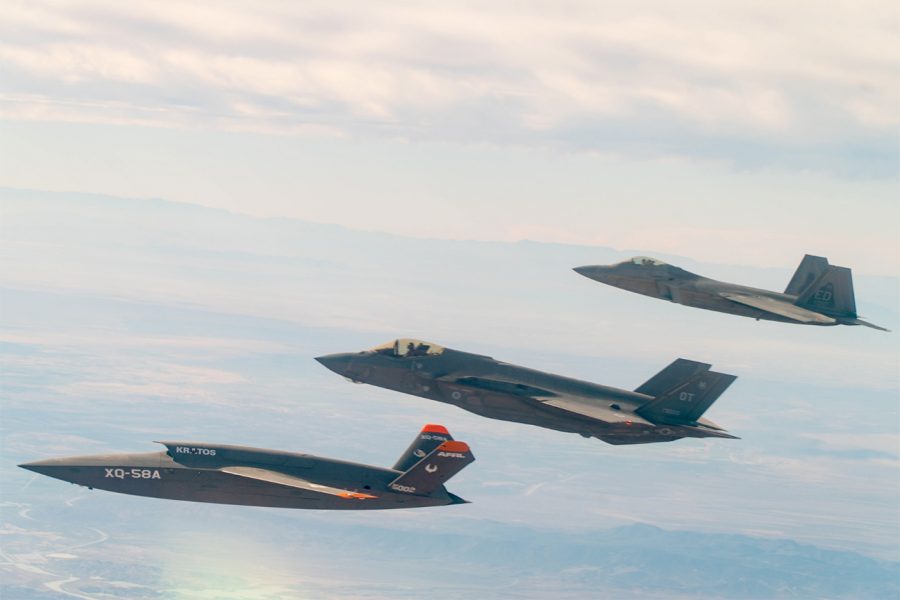The Air Force is launching a months-long study of tactical aviation requirements, seeking a force mix that addresses both near- and long-term requirements, which will be available in time to inform the fiscal 2023 budget request, Chief of Staff Gen. Charles Q. Brown Jr. said Feb. 17.
He wants the Pentagon’s Cost Assessment and Program Evaluation shop involved so the study will have credibility and buy-in from the Office of the Secretary of Defense.
USAF needs a fifth-gen capability, comparable to the F-22 and F-35, and a “sixth-gen” capability such as the Next-Generation Air Dominance fighter, but it also needs “a mix for the lower-end fight,” Brown told reporters on Feb. 17.
Although he acknowledged that former Air Force acquisition chief Will Roper opened the possibility of buying more F-16s for this purpose, Brown waved away that idea. The F-16, he said, lacks open mission systems capability, and gets operational flight program updates—new software—too infrequently. The aircraft was designed in the 1970s, and he is more interested in a “clean sheet design,” which he referred to as a “fourth-and-a half/fifth-gen minus” aircraft. The TacAir study will decide just what is needed, and in what numbers.
The study will parallel Defense Secretary Lloyd J. Austin III’s Global Posture Review, and the two assessments will “inform” each other.
“Right now, I wouldn’t say they’re aligned,” Brown said, noting this is another reason why he wants the CAPE involved. The TacAir study will require a lot of modeling and simulation, he said. The Global Posture Study will also lay out the “priorities of the department” and inform the direction of the TacAir assessment. To do it in “a vacuum … would be naïve,” he said.
Asked specifically about buying new F-16s, Brown said, “Actually, I want to build something new and different that’s not the F-16; that has some of those capabilities, but gets there faster, using our digital approach.”
He assumes that, “Not everybody will agree” with the study’s findings, but said, “We … want a point of departure, a point of dialog.” There will be risk associated with whatever optimum force mix emerges. “My job then is to articulate what that risk might be,” he added.
The Air Force’s fighter fleet averages 28 years old, and “that’s not going to compete well with adversaries,” Brown noted. “That’s why this force mix study is so important: to bring down the average age, to have something relevant not just today, but well into the future.”
Brown acknowledged that the Air Force is unlikely to be able to afford 386 combat wings, but said it might be possible to obtain the combat capability of that capability without as many actual aircraft.
“I want to … get as close as I can to a 386 capability with the force size I have and [the] dollars available,” he said, but there has to be solid analysis for the resulting force mix. He’s told the Air Staff and major commands, “I have a degree in engineering; it’s all about numbers and facts … That’s what I expect from the Air Staff, don’t give me emotion, bring me the facts.”
Brown said he has no doubt the major commands “understand I’m the Chief,” and said he is making “enterprise-level decisions” about the force structure. Those decisions are “not going to be popular,” he said. But, “If I don’t do that, we don’t accelerate change. I’m not sorry about that. There will be some folks who don’t like me, or don’t like what I decide, but I want to move forward with what I think is best for the Air Force.”
Combatant commanders have a different perspective, he noted, and are focused on a horizon of two or three years. Brown said he’s worried about that, too, but he also has to think about the “next 15-20 years. This is why I say we have to balance risk over time. I should not own all the risk … [it] has to be shared [with] the combatant commands and the services.” He said he’s thinking about the COCOMs that are the fifth successors to those now in the job, and he wants to “set them up for success.”
Not every mission will have everything it needs, Brown said. “That means tough choices.” The Air Force has to “look across portfolios.”
Brown acknowledged the F-35 is having engine wear issues, and said this will play in the TacAir review. The Air Force has the largest and “most mature” F-35 fleet, and is seeing F135 engines “failing a little faster in certain areas,” due to their “high use rate” and heavy deployment pace, given their relative newness in the fleet, he said.
Options are being looked at in maintenance and depot to mitigate the problem, Brown said, noting he has three- and four-star generals studying the issue.
But one big solution could simply be to use the F-35 less, Brown reported.
“I want to moderate how much we’re using those aircraft,” he said. “You don’t drive your Ferrari to work every day, you only drive it on Sundays. This is our ‘high end’ [fighter], we want to make sure we don’t use it all for the low-end fight … We don’t want to burn up capability now and wish we had it later.”
There’s “going to be some tension associated” with that approach, and “I fully expect that,” he said.

